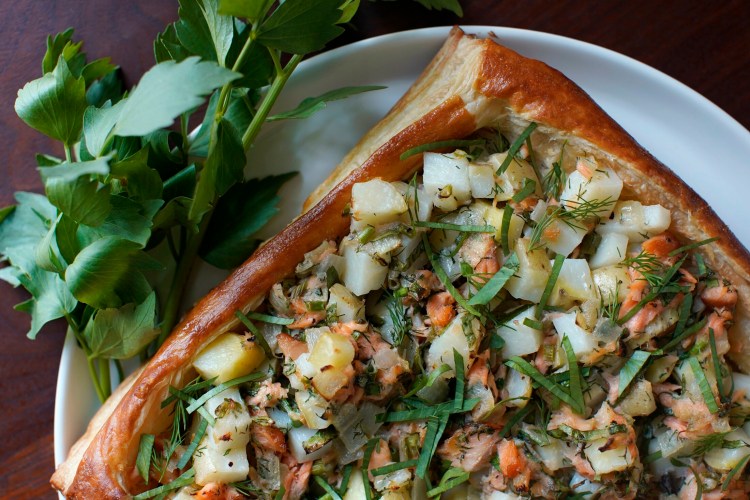Sipping lemonade through a straw fashioned from a young, thin lovage stem is a grand and glorious experience. It opens with a heady parsley scent; continues to a mingling of savory celery with sweet-sour lemon flavor; and leaves a subtle anise finish once the citrus washes away. I also can attest that this completely compostable straw – the hollow part of the stem, which extends from the soil up to where the first petiole branches off – does wonders for a Bloody Mary.
I bought three bunches of the first lovage of the season at the farmers market last week to explore what I could do with it. Turns out while there are plenty of ways to use this herb in savory and sweet dishes, a little fresh lovage goes a long way. That statement holds true about its potency as well as its many usable parts.
Native to western Asia and the Mediterranean, lovage was used by ancient Greeks and Romans for its medicinal properties. It was seen as a cure to everything from rheumatism to indigestion, stinky feet (they tucked it in their shoes as a deodorant) to a low sex drive – hence its nickname “love parsley.”
This hardy perennial herb grows well in USDA zones 4-8 from mid-April until late September. At the start of the season, the young, tender, skinny celery-like stalks are picked whole, and both the stem and the tender leaves are edible. As the season progresses, the stalks become fibrous, and you’re more likely to find only smaller bunches of lovage petiole with more mature, leathery leaves. These leaves can double for large, Italian flat-leaf parsley in form and function. When lovage bolts, it yields greenish-yellow flowers that are followed by golden-brown seed pods whose contents can be used like celery seeds in soups, stews and DIY pickling experiments.
Anywhere you use either celery or parsley in the kitchen, lovage also will work well; the leaves of the three closely resemble each other. But use a light touch when adding raw lovage to a dish because it’s much more potent than either of its cousins. If you love it, of course, add more. The flavor of lovage mellows with the heat so if you’re swapping it in for celery or parsley in a cooked dish, you can use them in equal measure.
The young celadon leaves available now – at the farmers market or in your garden – can be torn into pieces and tossed into leafy salads. They can be cut into thin ribbons and tossed with any lightly steamed or sauteed spring or summer vegetables. They can be chopped and tossed, with boiled potatoes and a vinaigrette for a picnic salad.
The young stems you don’t use as straws can be steamed; finished with melted butter and salt; and served as a side dish to chicken, pork or salmon. And early lovage pairs well with eggs – chopped leaves can be stirred into scrambled eggs just before serving, or chopped stems can be sauteed and then baked into frittatas, quiches or tarts.
As the leaves age, you’re better off chopping them more finely and stirring them into bread stuffing for poultry or using them to garnish chowders. A few of the tougher woody stems can be added to the stockpot as you would fennel stalks, or be simmered in equal parts sugar and water to yield a floral simple syrup to pour into glasses of soda water or into bowls of cut strawberries destined for shortcake.
What’s not to love?
Christine Burns Rudalevige is a food writer, recipe developer, tester and cooking teacher in Brunswick, and the author of “Green Plate Special,” a cookbook from Islandport based on these columns. She can be contacted at:
cburns1227@gmail.com

Christine Burns Rudalevige pours the salmon, potato and lovage mixture into a prebaked puff pastry shell. Brianna Soukup/Staff Photographer
Salmon, Potato and Lovage Tart
This recipe is one of those make-ahead stunners that only needs to be warmed through before serving. I use hot smoked salmon here because I like the color it adds. But you could substitute an equal amount of any hot-smoked fish, such as trout or bluefish.
Serves 4 to 6
2 tablespoons olive oil
1 medium onion, diced
2 bay leaves
3 soft lovage stems, thinly sliced
1 egg
Salt
2 sheets of puff pastry
1 pound yellow-fleshed potatoes, cooked and cut into ½-inch cubes
4-6 ounces hot smoked salmon, skinned and flaked
1 small handful lovage leaves, finely shredded, plus extra for serving
2 tablespoons finely chopped dill fronds, plus extra for serving
8 ounces creme fraîche
Warm the oil in a skillet over medium heat. Add the onions, bay leaves and lovage to the skillet, and cook slowly until soft, about 8 minutes. Remove and compost the bay leaves. Transfer the cooked vegetables to a bowl to cool.
Preheat oven to 400 degrees.
Whisk the egg with 1 tablespoon warm water and 1/4 teaspoon salt.
Lay 1 sheet of pastry on a baking sheet lined with a silicon mat or parchment paper. Use a pastry brush to paint a 1-inch egg frame on the pastry. Lay the other sheet of pastry on a cutting board and cut a 1-inch frame from it. Separate the frame from its cutout center (which can be wrapped and be used for another purpose) and place it on top of the egg-painted pastry. Use a fork to dock only the bottom layer of the pastry. Bake for 20 minutes until the pastry shell rises and turns golden brown.
To the bowl of cooled onions and lovage stems, add the potatoes, salmon, shredded lovage, and chopped dill and creme fraiche. Stir gently to combine and season to taste with salt. Spoon the filling into the pastry shell and return it to the oven to warm through, about 10 minutes. Garnish with more shredded lovage leaves and chopped dill. Serve warm.
Send questions/comments to the editors.



Comments are no longer available on this story